![]()
Sulphide Paperweights for Sale
![]()
Sulphide Paperweights for Sale
Sometimes a sulphide will have a silvery appearance due to a thin layer of trapped bubbles between the glass and the sulphide itself. Sometimes the sulphide material is not compatible with the glass and a fracture may develop.
The technique of encasing sulphide figures in glass dates from around 1750. Initially, the sulphides were found in glass plaques, flasks, goblets, and other objects. Paperweights came later. Sulphides are found in antique and modern paperweights from many factories. Three French factories made sulphides in significant quantieies during the 1950s, 1960s, and 1970s. Midwest American makers also made popular designs during the same period.
| 5628 | St. Louis 1981 Pope John Paul II Overlay
Sulphide Limited Edition Paperweight. dated
1981. This St. Louis sulphide paperweight features a ceramic
image of Pope John Paul II. It is encased in clear crystal and
a white overlay with a large top facet and six side facets, each
outlined with a circle of gold enamel. The base is finished
with a diamond (or waffle) cut. The sulphide is marked "GP
JEAN-PAUL II", the GP standing for the sculptor Gilbert Poillerat
who designed the cameo. The paperweight is signed near the
base with gold lettering "SL 1981". It also has its original
"CRISTAL SAINT LOUIS FRANCE" foil label and comes with its original
certificate of authenticity. This paperweight is number 21 out
of a limited edition of 100 overlay paperweights reserved for US
collectors. A wonderful paperweight in perfect
condition.
According to the two books on St. Louis paperweights, the Pope John Paul II sulphide was issued in an edition of 1,000 regular sulphides and 300 white overlays. Of these, 100 of the overlay paperweights were reserved for US collectors. Sulphides are cast objects (animals, flowers, people) made of a ceramic material that has properties similar to the surrounding glass. They are normally white, but are also sometimes colored or even painted. The objects are cast in a mold that copied or made directly from a medallion, coin or sculpture. The finest French sulphides are cast in a mold made by a skilled artist. Often a sulphide will have a silvery appearance due to a thin layer of trapped bubbles between the glass and the sulphide itself. Cristalleries de Saint Louis was founded in 1767 in Lorraine, which became part of France in 1766. The region was already home to several glassworks. Paperweight production started at St. Louis in 1845 and most likely continued until about 1860. Although the modern production of paperweights started in 1952, the output of millefiori and lampwork paperweights was small. Fewer than 400 lampwork and millefiori paperweights were made between 1952 and 1955. They were not all signed or dated. The most successful product of this early revival period was the Queen Elizabeth sulphide which was made to commemorate her coronation in 1953. After 1955, no additional weights were made at St. Louis until 1965. In 1965 the factory resumed production of lampwork and millefiori paperweights and then in 1967 they began a series of sulphide weights. Finally, in 1970 they started producing annual limited edition paperweights. Gilbert Poillerat (1902 - 1988) was a French designer, jeweler, and sculptor. He studied at the École Boulle, graduating in 1921. Initially he worked in wrought iron for Edgar Brandt doing design and production work. Later Poillerat branched out to design furniture and other decorative arts. In 1946 he became a professor at the École Nationale des Arts Decoratifs. He taught there for 26 years, all the while continuing his own design output, collaborating with the likes of André Arbus, Jean Pascaud, and Vadim Androusov. During the 1950s, Poillerat became involved in the rediscovery of the art of sulphide paperweights at Baccarat and St. Louis, contributing to many of the early modern sulphide paperweights. Large size: 3 1/16" diameter by 1 15/16" high.
The base is finished with a diamond (or waffle) cut. It is
faceted with a large top facet and six side facets. For extra pictures, click on the picture at the right and the following links: Large pictureSOLD. Click on the picture to see a larger image. |
Click
on the picture to see a larger image 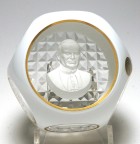 |
| 5636 | Norman
Rockwell Triple Self Portrait Limited Edition Sulphide
Paperweight. issued in 1979. This modern
sulphide paperweight features a three dimensional sulphide
interpretation of the famous 1960 painting by Norman Rockwell.
In the painting (and also the paperweight), Rockwell is depicted
with a pipe in his mouth painting a self-portrait while viewing
himself in a mirror. Rockwell had tacked four small images of
other self-portraits (by Durer, Rembrandt, Picasso, and van Gogh) to
the canvas, but only three are shown in the sulphide. He also
has sketches of himself in the upper left corner of the
canvas. The design is set on a translucent turquoise
ground. The sulphide was modeled by the American sculptor and
medalist Roger J. Brown who has signed his the sulphide R. J. Brown
twice. It was encased in crystal by an unnamed glass company
for the River Shore company. The paperweight was issued in a
limited edition of 2,500 paperweights, of which this is number
1,602. It is engraved on the base "Rockwell's TRIPLE
SELF-PORTRAIT by Roger J. Brown © 1979 River Shore Ltd. ® 1602 /
2500".
The paperweight is faceted with one large top facet and
five side facets and the footed base is star cut. This paperweight was sold under the collectibles brand River Shore, which was one of several companies that offered pieces by Roger J. Brown. I was unable to learn much about River Shore. And I was also unable to uncover which glass company made made it, but it was likely either Baccarat or D'Albret. Both of these companies also produced paperweights for the Franklin Mint during this period. Is it possible that this was a Paul Jokelson project? Sulphides are cast objects (animals,
flowers, people) made of a ceramic material that has properties
similar to the surrounding glass. They are normally white,
but are also sometimes colored or even painted. The
objects are cast in a mold that copied or made directly from a
medallion, coin or sculpture. The finest French sulphides
are cast in a mold made by a skilled artist. Sometimes a
sulphide will have a silvery appearance due to a thin layer of
trapped bubbles between the glass and the sulphide itself. Roger J. Brown (1933-2006) was born
in Jersey City, NJ and originally was in Data Processing with an
MBA from Fairleigh Dickinson University. He started
sculpting in 1963 and created an impressive variety of
figurines, medallions, and busts on many topics. He had
commissions from the Rockwell Society, Westminster Kennel Club,
and others. His work is represented in a number of museums
including the Aviation Hall of Fame, Whitney Museum of American
Art in New York City and the Remington Museum in Ogdensburg, NY. Large size: Just over 2 13/16" diameter by just
under 1 7/8" high. The paperweight is faceted with
one large top facet and five side facets and the footed base is
star cut. For extra pictures, click on the picture at the right and the following links: Large picture$39 postage paid in the US. Click on the picture to see a larger image. |
Click
on the picture to see a larger image |
| 5341 | Antique Sulphide of Young Napoléon
Bonaparte - Probably Clichy. circa 1848-1852.
Napoleon III (Charles-Louis Napoléon Bonaparte; April 20, 1808 to
January 9, 1873) was the first president of France from 1848 to
1852, and the last monarch of France as Emperor of the French from
1852 until he was deposed in absentia on September 4, 1870.
This paperweight features an image of a younger Napoléon Bonaparte
as he wore his facial hair around the time he was elected President
of France at the age of 40. Unfortunately the appearance of
the paperweight is marred by a bubble in front of the tip of his
nose. This would be a good addition to a collection of
sulphide paperweights or a collection of French historical objects. Sulphides are cast objects (animals,
flowers, people) made of a ceramic material that has properties
similar to the surrounding glass. They are normally white,
but are also sometimes colored or even painted. The
objects are cast in a mold that copied or made directly from a
medallion, coin or sculpture. The finest French sulphides
are cast in a mold made by a skilled artist. Often a
sulphide will have a silvery appearance due to a thin layer of
trapped bubbles between the glass and the sulphide itself.
Antique sulphide paperweights are fairly rare and many are
believed to have been made by Clichy. Clichy paperweights are highly
sought after by collectors for their complex canes and brilliant
colors. Clichy paperweights with rose canes are especially
desirable. The Clichy factory was founded at Billancourt
near Paris in 1837. Shortly after that it moved to
Clichy-la-Garenne, which gave the factory its best known
name. They stayed in operation until about the
1870s. Size: Just under 2 5/8” diameter by 1 13/16” high.
The base is ground concave. For extra pictures, click on the picture at the right and the following links: Large pictureSOLD. Click on the picture to see a larger image. |
Click
on the picture to see a larger image  |
|
|
Unique Baccarat 1964 JFK Sulphide Double
Overlay Paperweight. dated 1963, issued 1964. This
modern Baccarat sulphide paperweight features a large three
dimensional figure of President John F. Kennedy. Even
though it is dated 1963, I believe it wasn't issued until 1964 after
Kennedy was assassinated. The sulphide figure was designed by
Albert David. It has a cobalt blue and white overlay with a
red base. The paperweight is faceted with one large top facet
and five side facets. The overlay has an unusual cutting with
half-circle notches between each facet. Only 201 copies were
made with this color combination, but the cutting may be
unique. It is signed on the edge of the sulphide "A. DAVID 63"
and has an acid etched Baccarat logo / mark on the base. An
extra nice example. Paul Dunlop provides a detailed study of the variations on this paperweight. This paperweight was made in several formats, including 308 overlays and 3,572 non-overlays. Of the overlays, 201 were like the example shown here with a red uncut base and a blue and white overlay. However not all of the 201 will have the same cutting on the double overlay as the glass workers at Baccarat were given some artistic freedom to vary the cutting. 35 more were finished with a star cut on the base. And 72 were made with a blue base and a red and white overlay. There were nine different formats for the 3,572 non-overlay versions. An additional 314 non-overlay weights with an amethyst base were issued in a memorial edition. Sulphides are cast objects (animals, flowers, people) made of a ceramic material that has properties similar to the surrounding glass. They are normally white, but are also sometimes colored or even painted. The objects are cast in a mold that copied or made directly from a medallion, coin or sculpture. The finest French sulphides are cast in a mold made by a skilled artist. Sometimes a sulphide will have a silvery appearance due to a thin layer of trapped bubbles between the glass and the sulphide itself. Baccarat was founded in 1776 in Alsace-Lorraine with the name of Verrerie de Sainte Anne. The original location was near the town of Baccarat. Today the firm is known as Compagnie des Cristalleries de Baccarat. In 1952, Paul Jokelson approached Baccarat with the idea of making sulphide paperweights again. In 1953 Baccarat resumed paperweight production with a series of sulphide paperweights the first of which were the unsuccessful Eisenhower sulphide followed by the Queen Elizabeth coronation sulphide. Millefiori paperweight production was resumed in 1957 and lampwork paperweights were re-introduced in the early 1970s. Baccarat stopped making this type of fine glass paperweights in 2002. You can read more about the Baccarat paperweights in his book Baccarat Paperweights - two centuries of beauty by Paul Dunlop or one of the older books on paperweights in general, such as The Encyclopedia of Glass Paperweights by Paul Hollister or World Paperweights by Robert Hall. Albert David (1896 - 1970) was a French sculptor and ceramist who studied under Jean Boucher at the École des Beaux-Arts in Paris. David exhibited in Paris at the Salon of the Société des Artistes Français, Salon d'Automne and the Salon des Artistes Décorateurs. He received an honorable mention in 1921, a gold medal at the 1937 Exposition Universelle and a third-class medal in 1938. His work was entered in the Art competitions at the 1924 Summer Olympics, but he did not win a medal. In 1938, he was was made a Chevalier of the Legion of Honor. He was particularly known for his flat reliefs and war memorials and also his pottery. In addition, he also designed plaques and medals. David served as an official sculptor for the Monnaie de Paris (Paris Mint), a government-owned institution responsible for producing France's coins. During the 1960s he designed sulphides for Baccarat, some of which were produced after his death in 1970. Large Size: 3 1/8" diameter by just over 2 1/8"
high. The base is polished flat is faceted with one large
top facet and five side facets. For extra pictures, click on the picture at the right and the following links: Large picture$235 postage paid in the US. Click on the picture to see a larger image. |
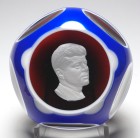 |
| 1539 | Vintage American George Washington
Sulphide Paperweight - Made by Eustachius and Ursula
Koering. dated 1949. This vintage sulphide
paperweight features a sulphide bust of George Washington.
Although it is encased in poor quality glass partially obscuring
sulphide, it is significant in that it is one of the earliest
confirmed examples of an American made sulphide paperweight.
The sulphide was sculpted by the well known illustrator Ursula
Koering and encased by her glassworker father Eustachius W. Koering,
possibly at the Koering Glass Company in Vineland, NJ. The
sulphide rests on a ground of clear glass with a concentric bubble
pattern on the base. It is signed on the back of the sulphide
"U.K. 3-18-49 EWK". The Koerings also made sulphide
paperweights of Abraham Lincoln, Pius XII, and a few others.
The plaster mold for the George Washington and other sulphides is in
the collection of the Museum of American Glass (Millville,
NJ). These paperweights sold in 1949 for $4.95 to $8.75
each. An important historical item worthy of a place in any
sulphide paperweight collection. Special thanks to Dr. James Barton for identifying the maker of this paperweight and for providing other background information about this maker. Sulphides are cast objects (animals, flowers, people) made of a ceramic material that has properties similar to the surrounding glass. They are normally white, but are also sometimes colored or even painted. The objects are cast in a mold that copied or made directly from a medallion, coin or sculpture. The finest French sulphides are cast in a mold made by a skilled artist. Sometimes a sulphide will have a silvery appearance due to a thin layer of trapped bubbles between the glass and the sulphide itself. Eustachius Wolfgang Koering (1886-1970)
was a principal in the Durand-Koering
Glass Company founded in Vineland
NJ in 1915 by Louis. J. Koering, George Deleruyelle, and Charles
Durand. Eustachius (sometimes spelled Eustacius) graduated from the Rensselaer Institute of
Technology with a degree in Chemical Engineering in 1917.
His thesis topic was “Design for a Glass Factory with a 14 Pot
Furnace.” By the 1920s, Eustachius was the head of the
Koering Glass Company (also of Vineland) in the 1920s and
applied for a trademark in 1928. He also applied for
several patents for glass towel bars in 1924 and 1926. I
was unable to determine whether this was the same firm as
Durand-Koering with a new name or a completely new firm. Ursula Koering (1921-1976), daughter of Eustachius, came from an artistic family. Her father, Eustachius W. Koering, and her maternal grandfather, Amour LeFevre, were glassblowers. Her paternal grandfather, Louis Koering, was a wagon maker and wood carver. Ursula's mother, Mariette LeFevre Koering, was a painter. When Ursula was a child, Mariette took her to the Philadelphia Museum of Art for Saturday art classes. Ursula loved working in clay and took classes in clay modeling and ceramics, eventually graduating from the Philadelphia College of Art which was then part of the Philadelphia Museum of Art and was later renamed the Philadelphia Museum School of Art. She was not able to develop a career as a sculptor and instead became an illustrator with children's magazine Jack and Jill and later for the publishers of children's books, illustrating more than two hundred books. Her original love for sculpting and ceramics no doubt led to the collaboration with her father in producing the Koering sulphides in the late 1940s. Large Size: 2 15/16" diameter by 2 3/8" high.
The base is concave with a snapped pontil mark (rough pontil) in
the center. For extra pictures, click on the picture at the right and the following links: Large pictureSOLD. Click on the picture to see a larger image. |
Click
on the picture to see a larger image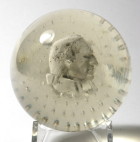 |
|
|
Modern St. Louis Cupid Amour Sulphide
Paperweight. dated 1979. This is a
modern St. Louis sulphide paperweight featuring a ceramic image of
cupid set on a opaque red ground and surrounded by a garland of blue
lampwork flowers with millefiori centers and green leaves.
There is an opaque white layer under the red layer which is visible
from the base. The paperweight was issued in a limited edition
of 400 in 1979. It is faceted with a large top facet and six
side facets. It is signed on the base with a millefiori
signature date cane "SL 1979". A great paperweight with
fantastic color. The conceptual design for the paperweight was by Linda Pope-Selman. Gilbert Poillerat sculpted the model for the image of cupid. The sulphide bears the title AMOUR and the initials of the sculptor (GP). Sulphides are cast objects (animals,
flowers, people) made of a ceramic material that has properties
similar to the surrounding glass. They are normally white,
but are also sometimes colored or even painted. The
objects are cast in a mold that copied or made directly from a
medallion, coin or sculpture. The finest French sulphides
are cast in a mold made by a skilled artist. Often a
sulphide will have a silvery appearance due to a thin layer of
trapped bubbles between the glass and the sulphide itself. Cristalleries de Saint Louis was founded in 1767 in Lorraine, which became part of France in 1766. The region was already home to several glassworks. Paperweight production started at St. Louis in 1845 and most likely continued until about 1860. Although the modern production of paperweights started in 1952, the output of millefiori and lampwork paperweights was small. Fewer than 400 lampwork and millefiori paperweights were made between 1952 and 1955. They were not all signed or dated. The most successful product of this early revival period was the Queen Elizabeth sulphide which was made to commemorate her coronation in 1953. After 1955, no additional weights were made at St. Louis until 1965. In 1965 the factory resumed production of lampwork and millefiori paperweights and then in 1967 they began a series of sulphide weights. Finally, in 1970 they started producing annual limited edition paperweights. Gilbert Poillerat (1902 - 1988) was
a French designer, jeweler, and sculptor. He studied at
the École Boulle, graduating in 1921. Initially he worked
in wrought iron for Edgar Brandt doing design and production
work. Later Poillerat branched out to design furniture and
other decorative arts. In 1946 he became a professor at
the École Nationale des Arts Decoratifs. He taught there
for 26 years, all the while continuing his own design output,
collaborating with the likes of André Arbus, Jean Pascaud, and
Vadim Androusov. During the 1950s, Poillerat became
involved in the rediscovery of the art of sulphide paperweights
at Baccarat and St. Louis, contributing to many of the early
modern sulphide paperweights. Large size: Just under 3 1/8" diameter by just under
1 5/8" high. The bottom is ground concave. For extra pictures, click on the picture at the right and the following links: Large picture$295 postage paid in the US. Click on the picture to see a larger image. |
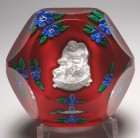 |
|
|
Antique New England Glass Company Sulphide
Paperweight of Lajos Kossuth. circa 1851. Antique
Sulphide paperweight featuring Lajos Kossuth, former
Governor-President of Hungary. It is inscribed on the back
"EX-GOVERNOR OF HUNGARY SET AT LIBERTY BY THE PEOPLE OF THE UNITED
STATES OF AMERICA 1851".
Kossuth was a political reformer who fought for liberty for Hungary and held the office of Governor-President from April 14 to August 11, 1849. He was appointed to this position after the declaration of Hungarian independence from the Hapsburg Monarchy. He was widely honored during his lifetime as a freedom fighter and advocate of democracy in Europe. He demanded parliamentary government for Hungary and constitutional government for the rest of Austria. After abdicating the post of Governor-President he was effectively under house arrest until he was allowed to leave the Ottoman Empire in September 1851 on the American frigate Mississippi. He then toured Britain and the United States in a futile effort to get support for his cause. He won favor in New England and souvenirs and other commemorative items were created to celebrate his visit. This paperweight was probably one of the commemorative objects created around the time of his visit. Some authors suggest the inscription refers to US support of his cause. Instead, I think it may refer to his rescue from house arrest by the US. New England Glass Company (NEGC) operated in Cambridge, Massachusetts from 1818 to 1888. You can read about paperweights from the New England Glass Company in the book by Hawley, The Art of the Paperweight - The Boston & Sandwich and New England Glass Companies. Most texts attribute this paperweight to the New England Glass Factory. It is believed that this paperweight may have been made for the 1851 Great Exhibition at the Crystal Palace in London. However, the attribution is subject to challenge and the precise origin of this sulphide paperweight remains elusive. The Bergstrom Mahler Museum has an identical paperweight which they attribute to Clichy. Hawley attributes this to NEGC in his 1997 book The Art of the Paperweight - The Boston & Sandwich and New England Glass Companies. However, in his latest 2011 book on NEGC, he states that no firm evidence exists for this attribution, except that the specific gravity and fluorescence match that of NEGC. Hollister discusses this paperweight in his Encyclopedia of Glass Paperweights and also states that their is no firm evidence tying the paperweight to NEGC or any other factory. My own opinion is that the glass quality is more typical of NEGC than the French factories. It may have originated in Europe or at another American factory. Ignore the glare from the lights. It was difficult to photograph this paperweight. The sulphide is white. Size: 2 9/16" diameter by 1 11/16" high. The
base is ground concave. For extra pictures, click on the picture at the right and the following links: Large picture of the paperweightSOLD. Click on the picture to see a larger image. |
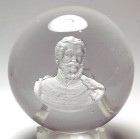 |
| 5202 | Baccarat 1955 Sulphide Double Overlay
Paperweight of Marquis de Lafayette with a Diamond Cut Base.
dated 1955. This modern sulphide paperweight
features a large three dimensional figure of the Marquis de
Lafayette. The sulphide figure was designed by Gilbert
Poillerat. It has a light blue and white overlay with a clear
glass ground and a diamond cut base. Only 159 copies were made
in this color combination. It is signed on the edge of the
sulphide "B. G.P. 1955" for Baccarat, Gilbert Poillerat,
1955. The paperweight is faceted with one large top facet and
five side facets. An extra large example. This paperweight was made in several formats, including 227 overlays and 744 non-overlays. Of the overlays, 159 were in light blue and white. The remainder of 68 was in a blue overlay with a blue jasper ground. Note on condition: The condition of this paperweight is excellent with no chips, cracks, or noticeable scratches. However the light blue overlay has several flaws from the manufacturing process. There are at least two small popped bubbles and lines where the color varied. From Wikipedia: Marie-Joseph
Paul Yves Roch Gilbert du Motier, Marquis de La Fayette
(6 September 1757 – 20 May 1834) (known in the United States
simply as Lafayette) was a French aristocrat and military
officer who fought in the American Revolutionary War, commanding
American troops in several battles, including the Siege of
Yorktown. After returning to France, he was a key figure
in the French Revolution of 1789 and the July Revolution of
1830. Sulphides are cast objects (animals, flowers, people) made of a ceramic material that has properties similar to the surrounding glass. They are normally white, but are also sometimes colored or even painted. The objects are cast in a mold that copied or made directly from a medallion, coin or sculpture. The finest French sulphides are cast in a mold made by a skilled artist. Sometimes a sulphide will have a silvery appearance due to a thin layer of trapped bubbles between the glass and the sulphide itself. Baccarat was founded in 1776 in Alsace-Lorraine with the name of Verrerie de Sainte Anne. The original location was near the town of Baccarat. Today the firm is known as Compagnie des Cristalleries de Baccarat. Most collectors refer to three periods of Baccarat paperweight production.
In 1952, Paul Jokelson approached Baccarat with the idea of making sulphide paperweights again. In 1953 Baccarat resumed paperweight production with a series of sulphide paperweights the first of which were the unsuccessful Eisenhower sulphide followed by the Queen Elizabeth coronation sulphide. Millefiori paperweight production was resumed in 1957 and lampwork paperweights were re-introduced in the early 1970s. Baccarat stopped making this type of fine glass paperweights in 2002. You can read more about the Baccarat paperweights in his book Baccarat Paperweights - two centuries of beauty by Paul Dunlop or one of the older books on paperweights in general, such as The Encyclopedia of Glass Paperweights by Paul Hollister or World Paperweights by Robert Hall. Large Size: 3 1/8" diameter by just over 2"
high. The paperweight has a diamond cut base and is faceted
with one large top facet and five side facets. For extra pictures, click on the picture at the right and the following links: Large pictureSOLD. Click on the picture to see a larger image. |
Click
on the picture to see a larger image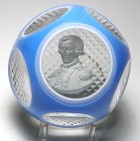 |
| 5223 | D'Albret 1975 Double Overlay
Sulphide Paperweight of Charles Lindbergh. dated
1975. This modern sulphide paperweight features a large three
dimensional figure of the Charles Augustus Lindbergh. The
sulphide figure was designed by Gilbert Poillerat. It has a
light blue and white overlay with a clear glass ground and a fancy
cut cog edged footed base. This paperweight is faceted with
one large top facet and six side facets. Only 170 copies were
made with an overlay. It is signed on the front edge of the
sulphide "C A LINDBERGH GP 75". It is also etch signed in the
center of the base "CR. D'ALBRET - FRANCE". The paperweight
comes with its original Paul Jokelson blue box marked "CHARLES A.
LINDBERGH by G. POILLERAT CRISTAL D'ALBRET FRANCE P.J." A
great addition to any collection of historical sulphides. This paperweight was made in two formats for a total of 570 paperweights, including 170 blue and white overlays and 400 non-overlays. All of the non-overlay paperweights had a cobalt blue ground. Charles Augustus Lindbergh was an
American aviator, military officer, author, inventor, and
activist. At the age of 25 in 1927, he went from obscurity as a
U.S. Air Mail pilot to instantaneous world fame by making a
nonstop flight from New York City to Paris. (from Wikipedia) Sulphides are cast objects (animals, flowers, people) made of a ceramic material that has properties similar to the surrounding glass. They are normally white, but are also sometimes colored or even painted. The objects are cast in a mold that copied or made directly from a medallion, coin or sculpture. The finest French sulphides are cast in a mold made by a skilled artist. Sometimes a sulphide will have a silvery appearance due to a thin layer of trapped bubbles between the glass and the sulphide itself. Cristalleries et Verreries de Vianne was
founded in 1918 with the reorganization and reestablishment of a
glassworks in the town of Vianne, France following World War
I. The company specialized in making lighting fixtures
when they were approached in 1967 by Paul Jokelson with a
proposal to make sulphide paperweights. They accepted
Jokelson's proposal and successfully made a variety of sulphide
paperweights under the label Cristal d'Albret.
Jokelson was the US distributor for most, if not all, of these
products. Large Size: 3 1/8" diameter by just under 1 15/16"
high. The clear base has a fancy cut with a concavity in the
center. The paperweight is faceted with one large top facet
and six side facets and is footed. For extra pictures, click on the picture at the right and the following links: Large pictureSOLD. Click on the picture to see a larger image. |
Click
on the picture to see a larger image |
Revised 10/1/2023